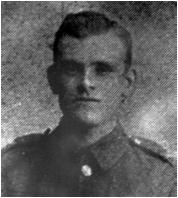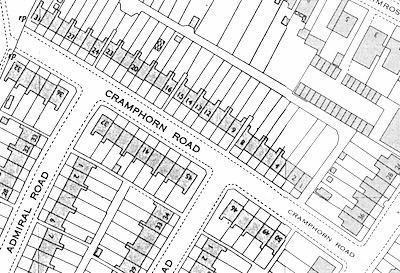William A. J. Clarke (sometimes ‘Clark’) was born and raised in Tollesbury, coming to Chelmsford by 1911 where he worked at Hoffmann’s. He joined the Territorial Army in 1911, volunteered for overseas service leaving for Gallipoli in July 1915. He was killed there the following month. His family home was in Cramphorn Road.
CLARKE, WILLIAM A. J.,
Private, 1/5th Battalion, Essex Regiment
Stops were made at Malta and Alexandria in Egypt, before sailing to Mudros Bay on the small Greek island of Lemnos. From there the battalion sailed towards Gallipoli, transferred to flat-bottomed boats and were put ashore at A Beach, Suvla Bay on 9th August 1915 as reinforcements to troops that had landed there over the previous three days. There were no casualties in William’s battalion, which moved inland on the evening of 11th August 1915 to fill a gap in the line between the 53rd and 10th Divisions. The next morning the battalion occupied the reserve line. At 5.55 p.m. on 14th August 1915 the battalion, with comrades from the remainder of the 161st Brigade, moved up to relieve the 163rd Brigade which had established themselves close to the village of Anafarta Ova.
A post-war account on the battalion recalled:
“The advance of the 161st Brigade in daylight earned the admiration of Australian troops watching it from Anzac. the 5th Essex were in the centre, with the 6th [Essex] and 7th [Essex] on the flanks. It was the baptism of fire for the Brigade and though they were met with a furious fusillade as the advanced steadily over the plain, there was no hesitation. The Battalion reached the line and worked all night consolidating the position.”
At some point during that day, 14th August 1915, William who was a signaller, was shot in the head and killed. He was aged 22. According to one post-war history of the battalion 14 non commissioned officers and men were killed in the advance and about 30 wounded.
His death was reported in the Essex County Chronicle on 15th October 1915:
“Pte. W. Clarke, 5th Essex, who was killed while in action at the Dardanelles between the 14th and 15th August, was the son of Mr. and Mrs. Clarke, of 39 Cramphorn Terrace, Chelmsford. He was a signaller in the regiment and 22 years of age. He had been in the 5th Essex four years, during which time he worked at Hoffmann’s. Mr. and Mrs. Clarke are natives of Tollesbury. In letters to the deceased’s parents, Sergt. A. E. Thompson says: ‘Pte. Clarke was killed while advancing to the firing line, shot in the head and died instantly’. He was a good signaller, of a very willing and bright disposition, and much liked in his section. The regiment had been under shell fire and sniping ever since landing on the Peninsula, and your son’s death was due to his strong sense of duty, he having during the advance lost touch of his section, and though advised by me to wait until dusk to find it he felt it his duty to get to his section as soon as possible, and he had no sooner got on his feet to proceed that he was shot in the neck by a Turkish sniper. I hope it will console you to know that your son was not a shirker, but died doing his duty as a soldier and a man.’ A portrait of the deceased soldier will appear in the next Essex County Chronicle.”
William’s sergeant wrote the following in a letter to his parents:
“Private Clarke was a good signaller, of a very willing and bright disposition and much liked in his section...Your son’s death was due to his strong sense of duty. During the advance he lost touch with his section and although advised by me to wait until dusk, he felt it his duty to get to his section as soon as possible. He had no sooner got on his feet to proceed than he was shot in the head and died instantly. I hope it will console you that your son was not a shirker, but died doing his duty as a soldier and a man.”
William has no known grave and is commemorated at Helles Memorial in Turkey, on the Civic Centre Memorial, Chelmsford, on the Hoffmann War Memorial at Chelmsford Cathedral, and on the war memorial in front of St Mary’s Church, Tollesbury. He was entitled to the 1914-15 Star, British War Medal, and Victory Medal.
The 1918 register of electors recorded his parents living at 39 Cramphorn Road, Chelmsford, a street of 50 houses off the west side of Rainsford Lane, subsequently redeveloped as Cramphorn Walk.
His mother died in Chelmsford in 1949.
130914

William was born at Tollesbury in 1893, the son of William James Clarke and Matilda Clarke (nee Foakes). His father had been born in 1868 in Tollesbury; his mother in 1867 at Salcot. They had married on 9th February 1889 at Salcot and in 1891 had been resident in Tollesbury.
He had an elder sister Agnes Eliza Clarke, born in 1890 in Tollesbury.
At the time of the 1901 census William was aged seven and living with his parents and elder sister at West Street, Tollesbury. His father was a shipyard labourer. A decade later the next census recorded William, then 18, working as a labourer and lodging in the household of Joseph and Matilda Ginn at 20 Railway Street in Chelmsford. HIs elder sister was visiting him on census night.
That year (1911) William enlisted at Chelmsford into the 1/5th Battalion of the Essex Regiment, serving as Private 1453. The battalion was a Territorial unit formed in 1908 with its headquarters in Market Road, Chelmsford, and it naturally contained many Chelmsford men who were to lose their lives in the war. The term ‘territorial’ indicated that the volunteers such as William who served with the battalion were under no obligation to serve overseas, with their focus on home defence, but many like him agreed to serve abroad after the declaration of war on 4th August 1914.
At the outbreak of the war William’s battalion and the other Territorial battalions that formed the Essex Brigade were half way through their fortnight’s annual training at Clacton. On 3rd August 1914, the day before war was declared, William’s battalion was initially ordered back to Chelmsford, but that was countermanded and the battalion marched for Dovercourt that afternoon. The following day mobilization papers were issued to all ranks and the battalion was alloted part of a pre-arranged defensive line west of Dovercourt.
On 9th August 1914 the battalion was sent to Brentwood. It did not stay there long, moving to north-east Norfolk by the end of the month. In April 1915 it moved to West Bergholt, before transferring to St. Alban’s in Hertfordshire the middle of the following month. By then the battalion, along with three other Essex Territorial battalions formed the 161st (Essex) Brigade in the 54th (East Anglian) Division. The majority of the period since the outbreak of the war had been spent training in expectation of foreign service.


From St. Alban’s the battalion travelled to Devonport by train, and departed on board the S.S. Grampian on 23rd July 1915, with a somewhat depleted strength of 29 officers and 649 other ranks. Its ultimate destination was to be Gallipoli, Turkey to join the Allied forces participating in the campaign against the Turks which had started on 25th April 1915.